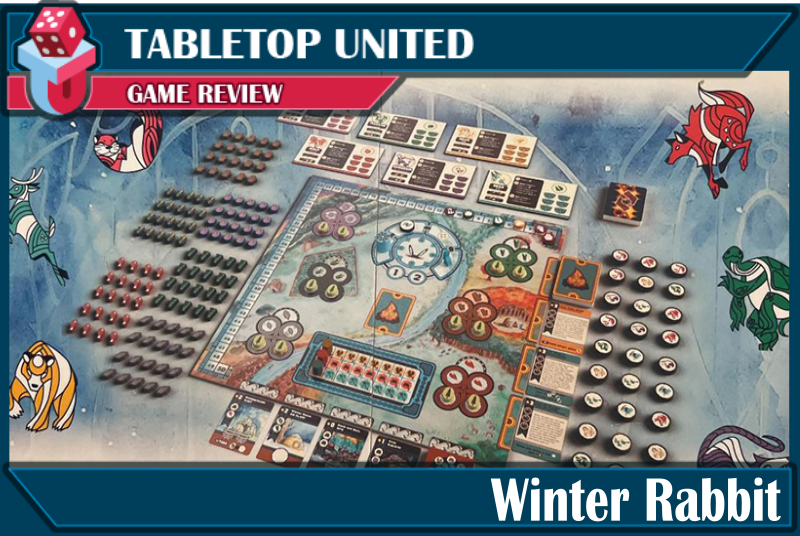Winter Rabbit
Designer: Will Thompson
Artist: Kindra Swafford (Illustrator) and Jonni Ketcher (Graphic Designer)
Publisher: Absurdist Productions
Year Published/ Kickstarted: Kickstarted August 2024
No. of Players: 2-6 players
Ages: 14+
Playing Time: 90 minutes
Main Mechanics/Theme:
Winter Rabbit is a semi-cooperative, hidden worker placement and resource gathering game
for 2-6 players based on the Cherokee legend of the game’s namesake, the Winter Rabbit.
The legend of the Winter Rabbit is told, throughout this game, about different animals that were preparing for the longest and coldest winter in history. While each animal has special talents to help gather resources and make supplies, the rabbit did not think that he had special talents, so he uses his wits to confuse the animals and steal their supplies. Your task is to work as a team to gather enough resources to make supplies to survive the winter while avoiding the thievery of the Winter Rabbit and gaining enough points to win the game. If your storehouse is not full by winter, everybody loses and the Winter Rabbit wins.
Disclaimer: Absurdist Productions provided the author an advance copy of this game for review. The final version may appear different than the photos contained in this review.
Overview:
Everybody works together to develop enough resources to survive the harsh winter. Once enough tools, food and clothing are developed, players battle it out to be the one with the most points at the end of the game. All of this has to happen while avoiding the Winter Rabbit because when the rabbit shows up, the hard work of your villagers gets taken.
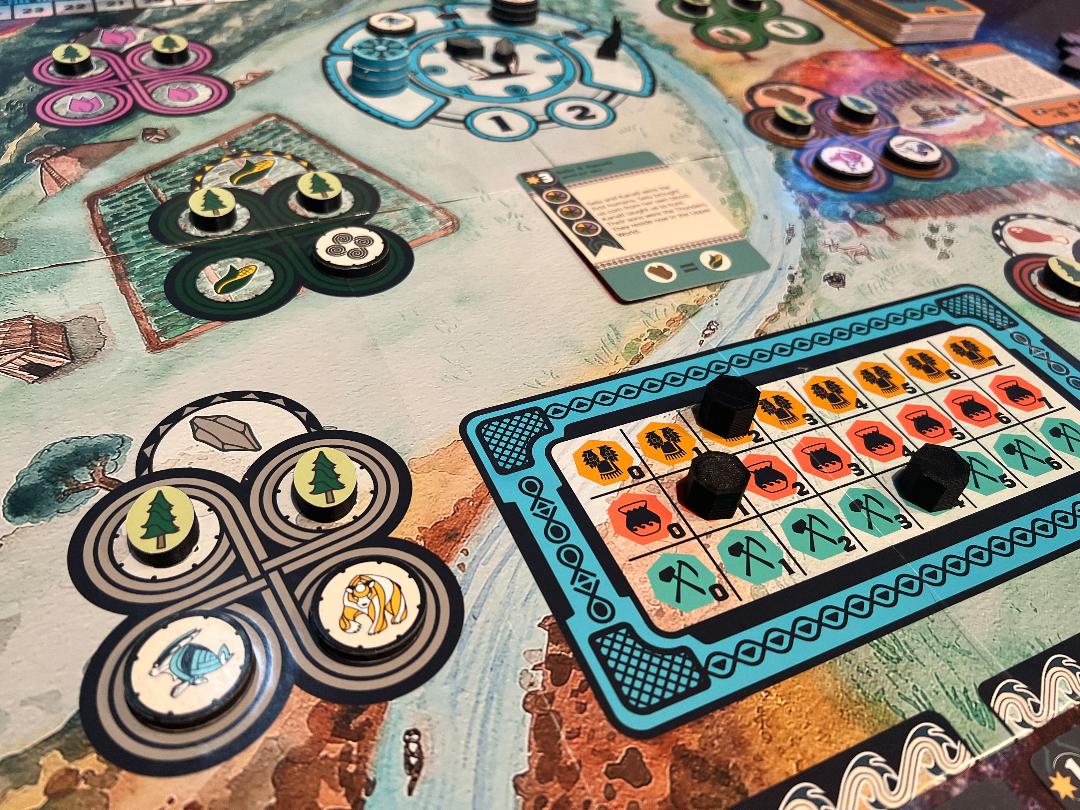
Gameplay and mechanics:
Players select an animal character to play. Their choices are the bear, deer, opossum, otter, terrapin and wolf. Each animal has different starting resources and a particular skill to manipulate resources. Each player gets a corresponding player mat and places ii in front of them.
The gameboard consists of various components.
There is a central season tracker that keeps track of the rounds of the game. When winter arrives and 4 frost tokens are drawn from the supply bag, the game ends. Within the season tracker, is the rabbit burrow where stolen resources are placed. This adds a 7th resource location to the board where players can compete to regain their stolen resources. I will discuss resource locations a little later in this review.
![]()
Also, centrally located, is the campfire where active stories can be told by paying resources. The stories told at the campfire, representing knowledge, legends, and practices passed down through oral tradition. Players can pay 3 resources to earn powerful immediate effects or long-lasting effects while the story card is active. 3 campfire cards, placed next to the gameboard, are available, at a time, for resource purchase to activate them.
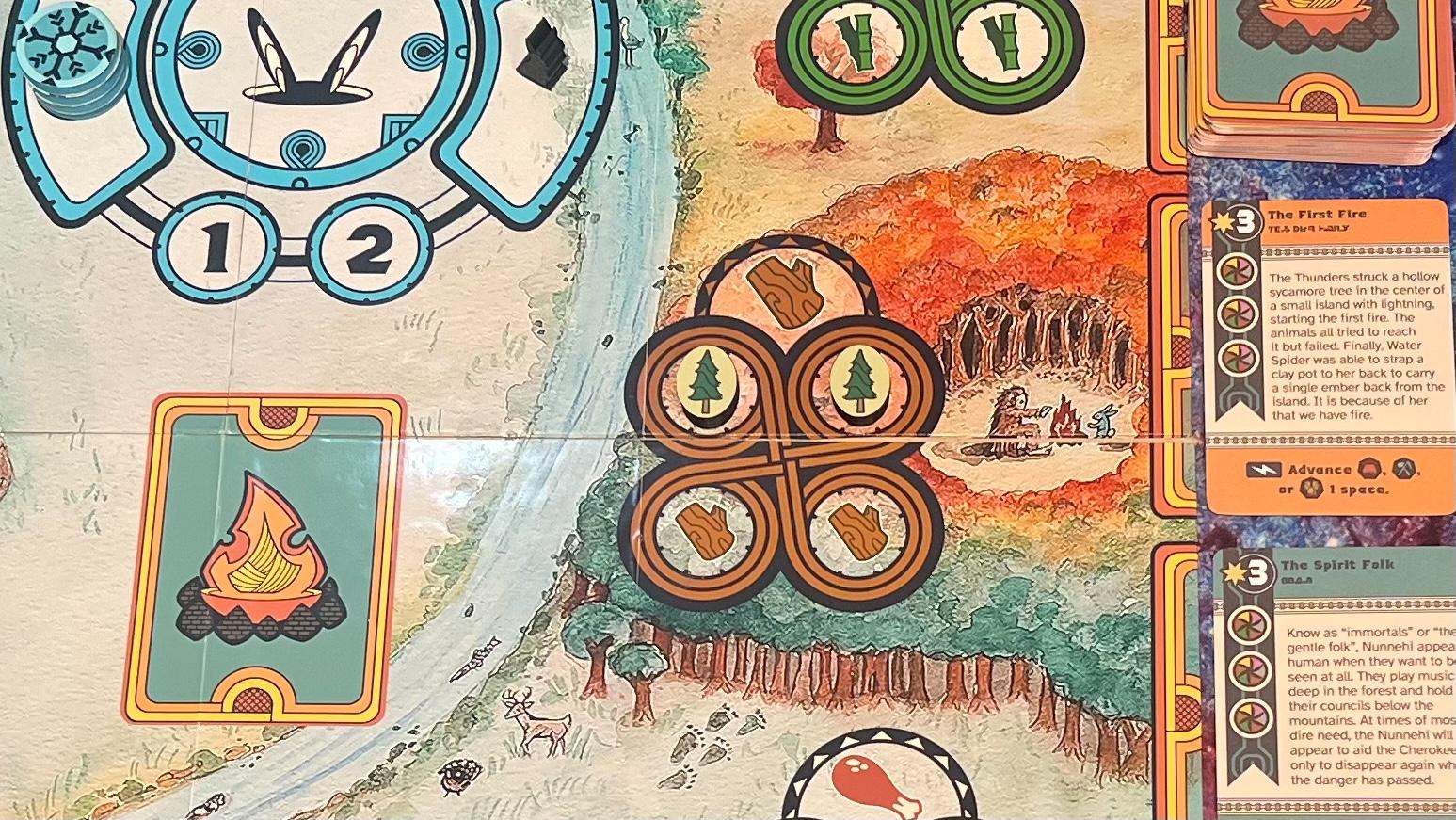
Below the campfire is the storehouse where players, cooperatively, keep track of the clothing, food and tools that have been prepared before winter arrives. As I mentioned before, players need to prepare 7 of each before the game ends.
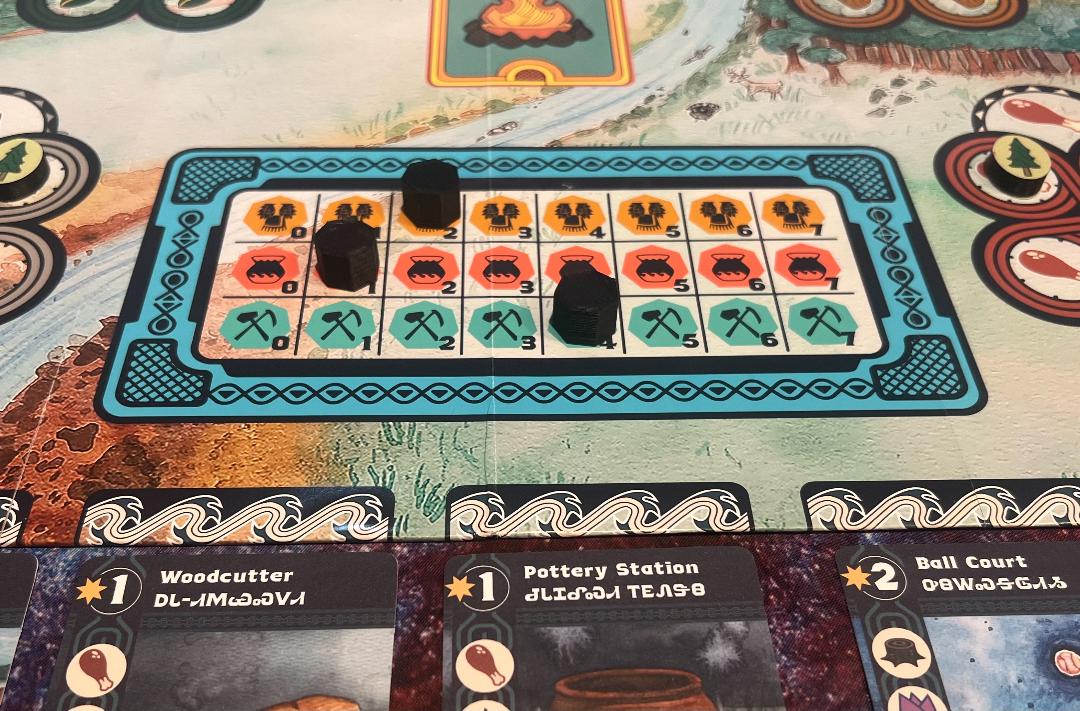
Around the outside edge of the board is the player point tracker while the interior of the board are the resource production locations representing the natural resources of wild game, crops, medicine wild plants, earth, wood and reeds. At the start of the game, each location gets 2 trees placed on them where land can be cleared to produce more of that resource, but less land conservation makes it more difficult for players in some aspects.
A resource bag gets a certain number, based on player count, of player villager tokens, neutral character tokens and rabbit tokens. As seasons progress, more tokens are placed into the bag.
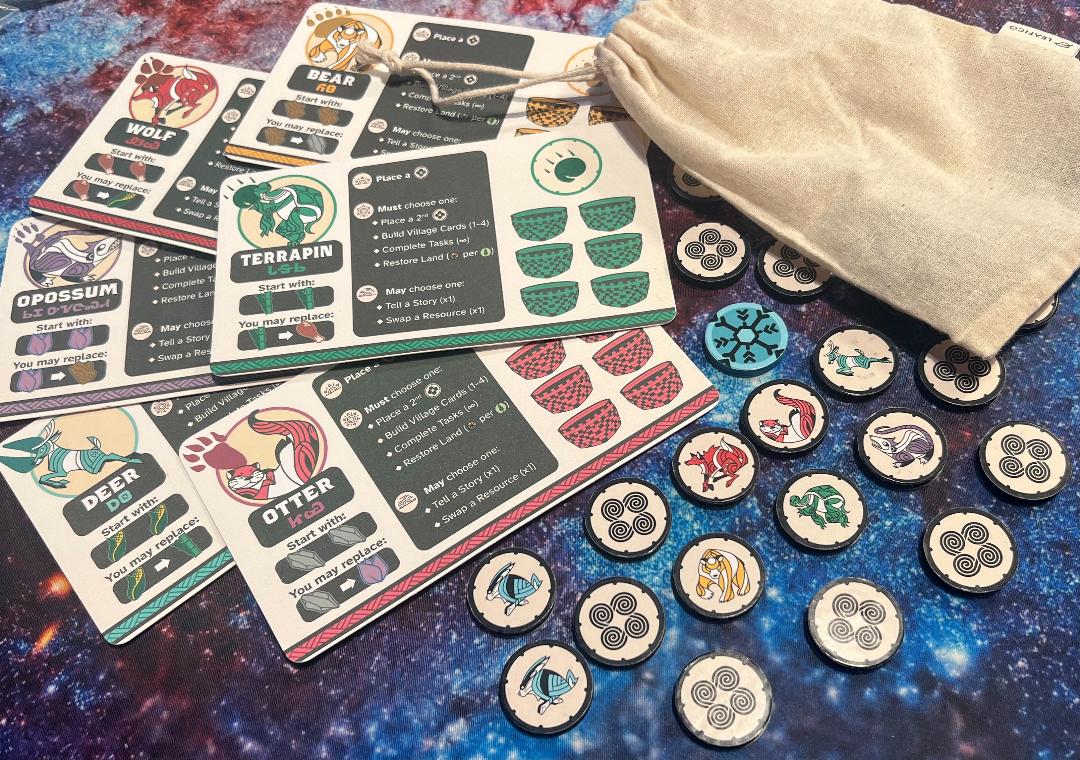
Available village cards are placed outside the bottom of the board.
Each player turn consists of a morning phase, midday, and evening phase.
During the morning phase, the current player draws a random villager token from the bag. They secretly look at it, and they must place it face down at one of the resource production locations, the available place on their player mat, or the rabbit burrow. Once a location has no more available places on it, tokens are revealed, and it immediately begins to produce resources for the players based on the icons on the tokens. Players have the option to clear land from a resource production location in order to place another village token. However, the tree icon is flipped to reveal the “stump” icon and it is placed onto one of the storage locations on the player mat reducing storage for that player.
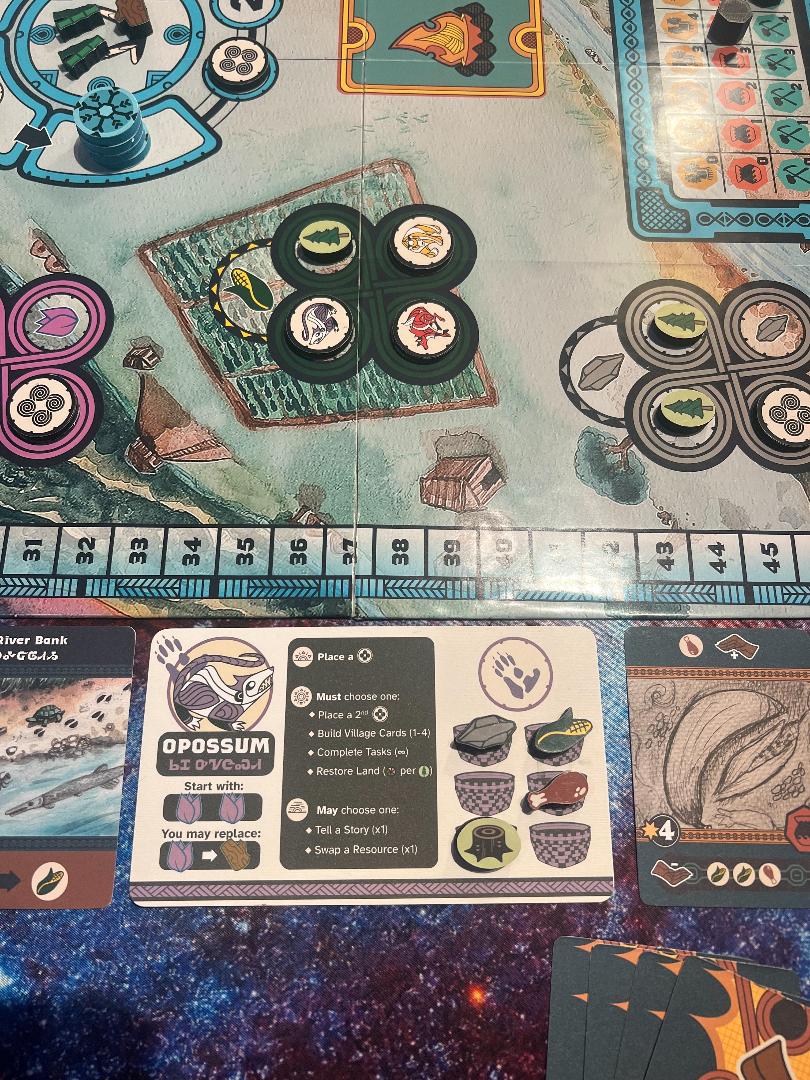
The midday phase gives the players several strategic options to play, however, they must and can only choose one. A player can place a second villager token from the bag or their player mat.
They can acquire village cards by paying the necessary, gathered resources to provide them additional storage spaces or individual skills.
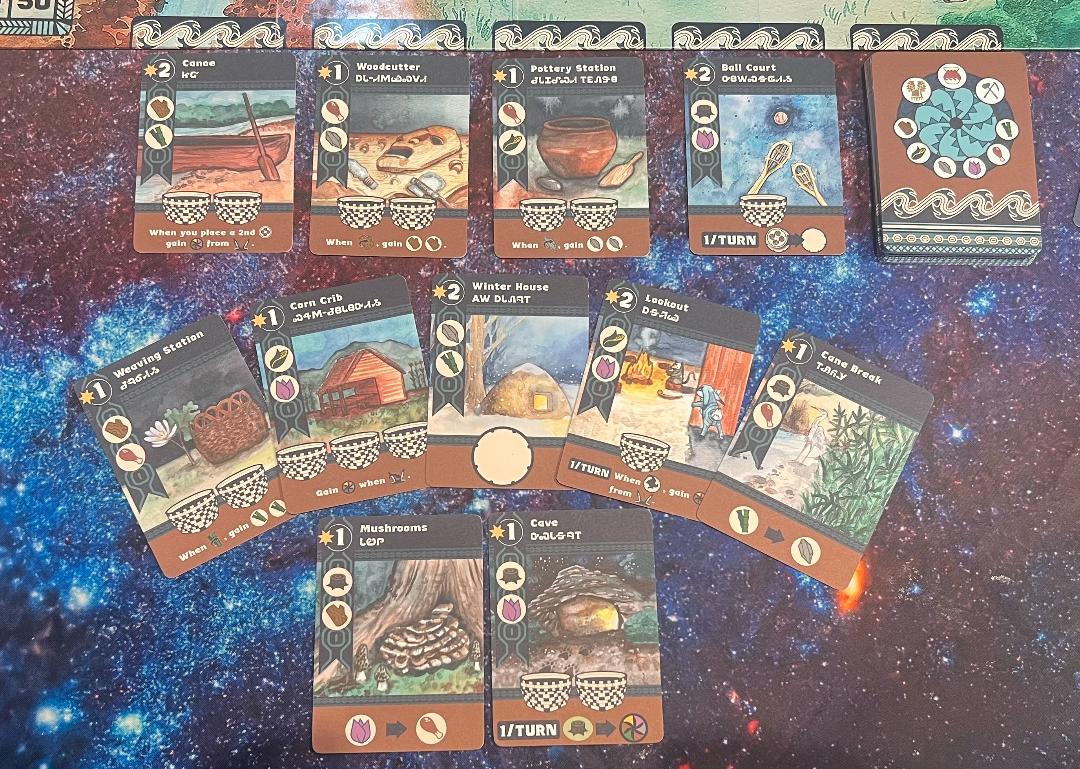
Players can complete other player tasks (they cannot complete one of their own tasks). At the start of the game, each player is dealt a number, based on player count, of task cards. Each season players get to select the required number of task cards for other players to complete.
When a task is completed that player earns the required number of points. The player who offers the task gets a reward, and the appropriate storehouse tracker is moved one place closer to the collective goal.
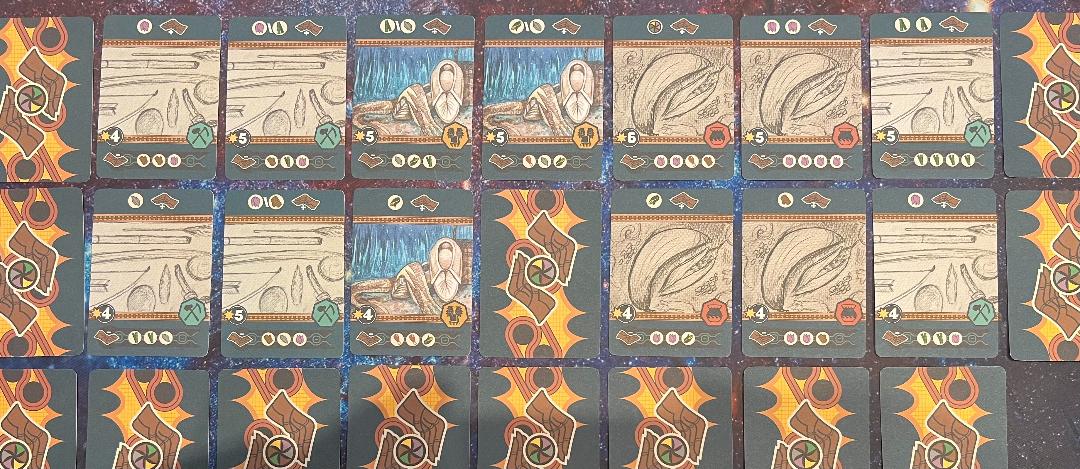
During the midday phase, the player may also select to restore land by paying one resource which removes the “stump” from their storage and a tree is returned to any resource production location on the board.
During evening, players may choose one option of paying 3 resources to tell a story or swap a resource, from a basket on their player mat, with an available resource in the supply.
Play continues until a player draws the last villager token from the bag which ends the season. The season tracker advances closer to winter and the board is reset for the next season.
Theme, Artwork and Illustration:
The game was designed and illustrated by members of the Cherokee Nation, and the gameplay and artwork successfully create the theme of the game. The beautiful watercolor artwork provides a nice backdrop for the bold color, Mandala style villager tokens, and player mats to make them “pop” and stand out. The instruction manual is beautifully illustrated as well, that was, to me, reminiscent of childhood books that my mom read to me when I was a little child. The card’s artwork follows the same suit while they provide some text in 2 different languages, English and a Cherokee language. With that being said, while this is not technically a story-based game, you get sucked into the story of the Winter Rabbit with every gameplay. The story cards provide a nice touch of adding ancestral information to the colorful artwork around you while playing.
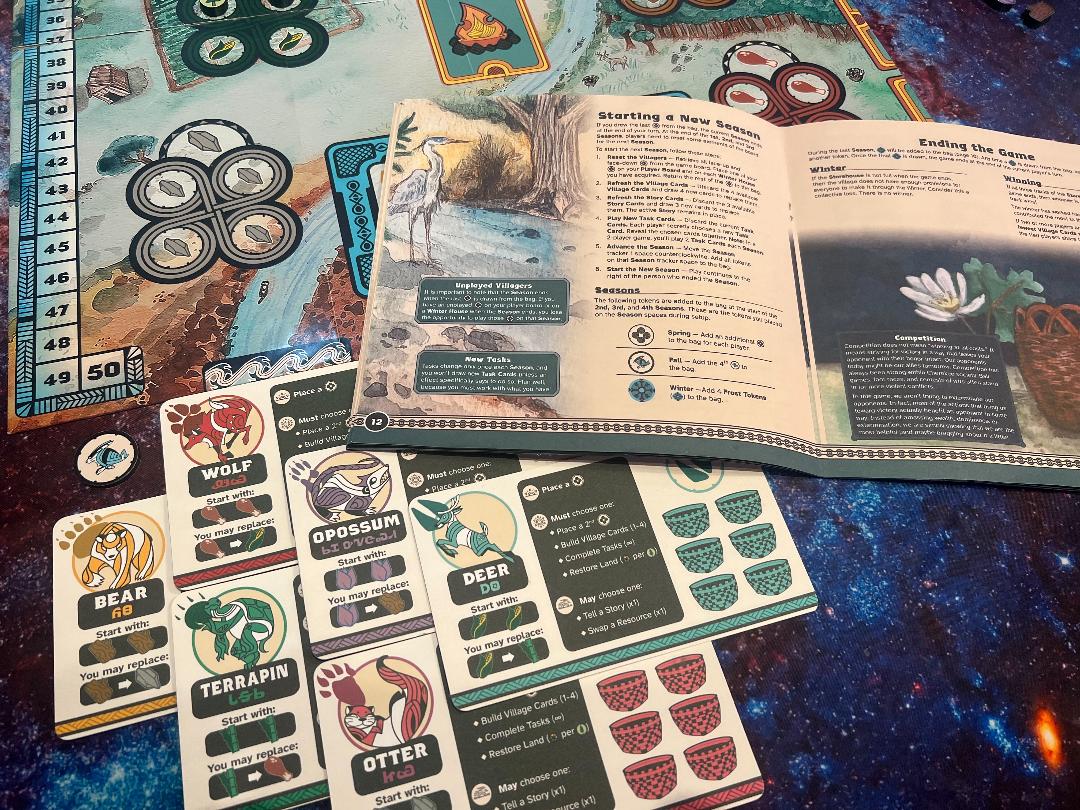
Inclusivity and Accessibility:
While this game has an indigenous background of the Cherokee culture, this game is for everyone. For me, it is an exciting childhood book brought to life in a competitive boardgame where everybody has to get along or they lose, yet there can only be one winner.
If you are into the historical or educational value of purchases, Winter Rabbit provides that as well.
While each player mat, villager token and resource symbols are color-coded, each have their own shape and design to easily distinguish them apart. Players with sensitivity to certain colors should be able to play this game. When setup, the game does take up average table space leaving a medium size footprint on your game table. Players may have to reach to place villager tokens on the various resource production locations. Resource tokens are small and should be kept out of reach of small children. The cards are easy to read with the smallest font, on the story cards, probably around 10 point. I had no issues reading any of the game text where I struggled with other games.
What worked:
I am going to be honest, I never had experience with a semi-cooperative, competitive game, and Winter Rabbit was my first try at one. At first, I was intimidated and overwhelmed to learn it. However, the instruction manual was clear, concise and easy to understand providing all of the necessary information to play the game.
The cooperative mechanics rely on strategy of which task cards to play for the other players to complete because completing tasks to fill the storehouse are the cooperative part of the game, but you don’t want the other players to score more points than you. You have to play a card based on the need of the entire village, yet you don’t want the others to score more points than you. It gets really interesting later in the game once the storehouse becomes full or nearly full. This is when the game jumps into a highly competitive mode. This factor was very unique because I do not own a game like that. It made me switch strategies every game even if I was playing with the same people. This makes this game’s replay value higher.
I liked the concept of conservation where it may be necessary to clear land for the sake of production, it does hinder your progress by taking away valuable storage space. It places you into a position where spending resources during midday to regrow the land will be beneficial.
The aspect of hidden worker placement adds a fun, stressful mechanic to the game. When placing the villagers, I enjoyed determining where to place workers that were not mine in order to get the most out of it for the cooperative side of the game and to benefit me the most. Then, you have to smartly decide where to place a Winter Rabbit token.
Final Thoughts:
I had a lot of fun with Winter Rabbit, as well as, everyone I introduced to the game. I logged two plays before I fully understood it and figured out a strategy to becoming successful meaning winning or coming close to winning. The artwork and graphic layout are amazing. Tension really builds as you are, collectively, trying to gain supplies in the storehouse. Once the storehouse was full, the game became super competitive where I found myself planning ways to make it more difficult for my opponents who were once my co-op players.
For those who like resource gathering or worker placement games, Winter Rabbit is for you. However, fans of those mechanics will like the twist of the hidden worker concept. I enjoyed the educational aspect of this game that dives into the Cherokee practices, legends and traditions. Even the instruction manual provides little heritage sidebars that compliments the beautiful artwork.
As I mentioned earlier in this review, I had zero experience with this type of game and loved it. I found it a nice and fun introduction to this genre, so if you are not a fan of this type of game or haven’t had the experience yet, you should try Winter Rabbit to join in on the fun.
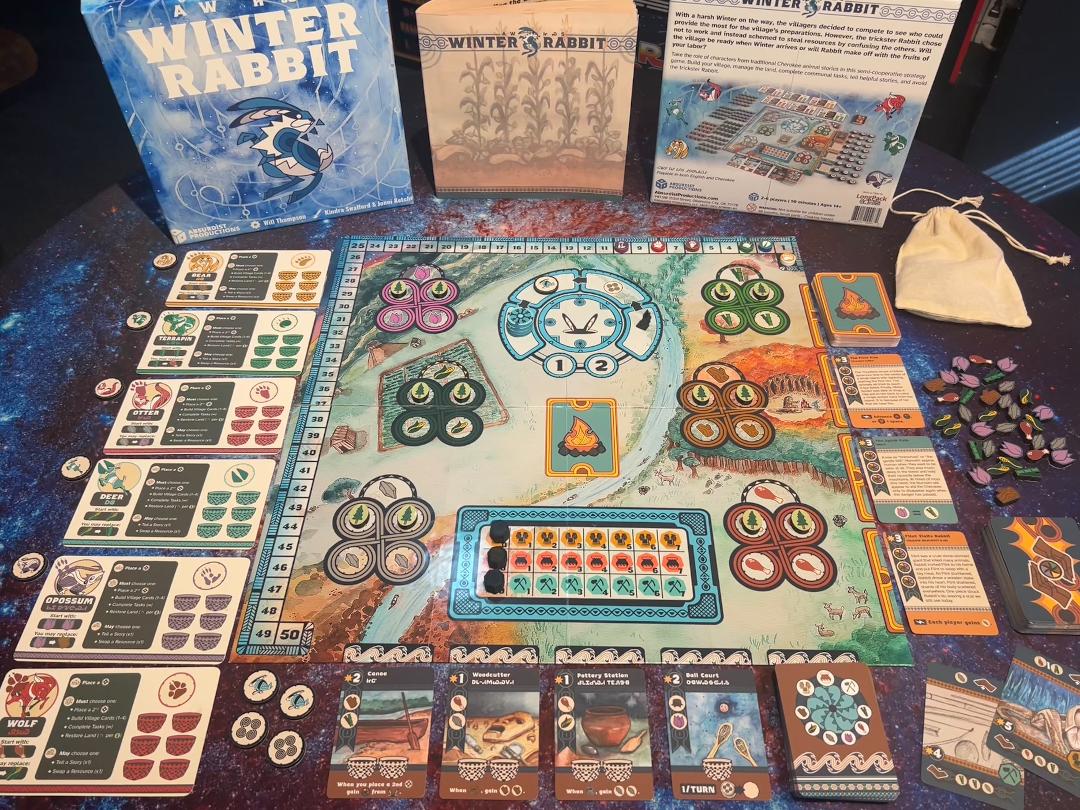
Check out about Winter Rabbit on Kickstarter:
https://www.kickstarter.com/projects/941694206/winter-rabbit
For more information about Winter Rabbit, click on the link to direct you to Board Game Geek:
https://boardgamegeek.com/boardgame/404517/winter-rabbit
If you liked this review, please consider joining us on our social pages or subscribing to our newsletter.
FB Community: https://www.facebook.com/groups/ttucommunity/
Instagram: https://www.instagram.com/tabletop_united/
Newsletter: https://www.subscribepage.com/tabletopunited


